Caudron G.III
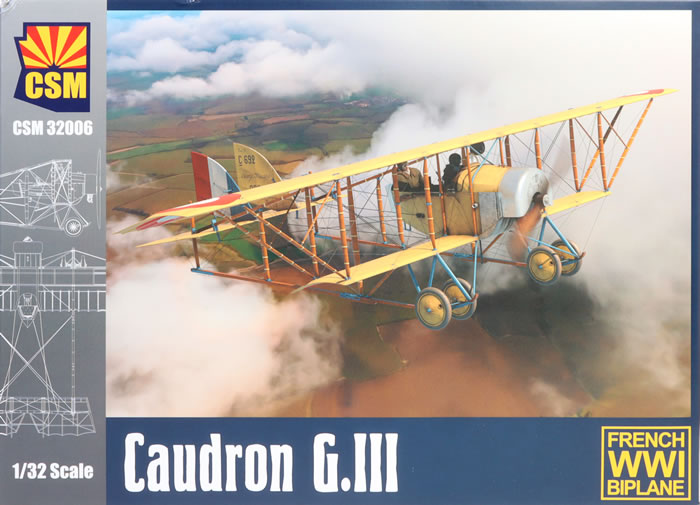
Copper State Models, 1/32 scale
S
u m m a r y : |
Description and Item No.: |
Copper State Models Kit No. 32006 - Caudron G.III |
Contents and Media: |
134 parts in pale grey plastic; four parts printed onto clear acetate sheet; six photo-etched parts on a single fret; markings for four aircraft.. |
Price: |
56.00 EUR plus shipping available online from Copper State Models' website
£50.39 plus shipping EU Price (£41.99 Export Price) available online from Hannants |
Scale: |
1/32 |
Review Type: |
First Look |
Advantages: |
High level of detail; subtle surface textures including stretched fabric and stitching; throughtful engineering to simplify struts; well illustrated and logically laid out instruction booklet including rigging called out progressively. |
Disadvantages: |
|
Recommendation: |
The Caudron G.III is a stringbag in all its soul and CSM captures its silhouette and soul very well.
It`s quite a risk taken here by CSM to release this spectacular aircraft, as its WWI and less know that Fokker and Albatros but thanks to CSM for taking that risk.
A glance at the parts and the instruction, the model is well thought out and modeler friendly as far as constructions goes. The rigging is not for fainted hearted, there's lots of it and it is very complicated.
This is the best Caudron G.III in any scale for sure, and it probably will for a very very long time and it`s in fact a very good looking model kit. |
Reviewed by Francesco Guedes

The Caudron G.3 was a single-engined French biplane, widely used in World War One as a reconnaissance aircraft and trainer.
The Caudron G.3 was designed by René and Gaston Caudron as a development of their earlier Caudron G.2 for military use. It first flew in May 1914 at their Le Crotoy aerodrome.
The aircraft had a short crew nacelle, with a single engine in the nose of the nacelle, and an open tailboom truss. It was of sesquiplane layout, and used wing warping for lateral control, although this was replaced by conventional ailerons fitted on the upper wing in late production aircraft. Usually, the G.3 was not armed, although sometimes light machine guns and small bombs were fitted.
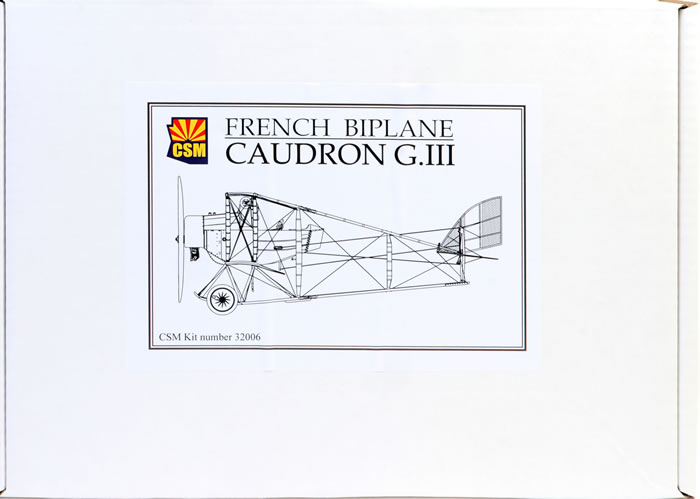
The Caudron G.3 first flew in 1914 serving as an observation aircraft. It had above average climbing ability and was considered suitable for use in mountainous terrain.
It was ordered in large quantities following the outbreak of the First World War with the Caudron factories building 1423 of the 2450 built in France. 233 were also built in England and 166 built in Italy along with several other countries. The Caudron brothers did not charge a licensing fee for the design, as an act of patriotism.
The G.3 equipped Escadrille C.11 of the French Aéronautique Militaire at the outbreak of war, and was well-suited for reconnaissance use, proving stable and having good visibility. As the war progressed, its low performance and lack of armament made it too vulnerable for front line service, and it was withdrawn from front line operations in mid-1916.
The Italians also used the G.3 for reconnaissance on a wide scale until 1917, as did the British RFC (continuing operations until October 1917), who fitted some with light bombs and machine guns for ground attack. The Australian Flying Corps operated the G.3 during the Mesopotamian campaign of 1915–16.
It continued in use as a trainer until well after the end of the war. Chinese Caudron G.3s remained in service as trainers until the Mukden Incident of 1931, when many were captured by the Japanese.
In 1921 Adrienne Bolland, a French test pilot working for Caudron, made the first crossing of the Andes by a woman, flying between Argentina and Chile in a G.3.
Specifications
Wingspan: 43 ft 11 in
Length: 21 ft 0 in
Gross Weight: 1612 lb
Powerplant: Gnome (80 hp)
Alternate Powerplant: LeRhone 9C (80 hp)
Alternate Powerplant: Anzani 10 (90 hp)
Top Speed: 68 mph (80 hp)/ 70 mph (90 hp)
Ceiling: 10,000 ft
Caudron also has its own history in the Portuguese Air Force.
Traslating from Portuguese Air Museum:
“In 1916, the first 16 Caudron, french origin, G3 arrive at Portugal, to assist in the instruction of pilots at the Military Aeronautics School of Vila Nova da Rainha.
They would be used in the “Esquadrilha Mista de Alverca” in 1918, the year this unit was created, and they inaugurated the Tancos runway in 1921, before returning to their original instruction mission, at the Escola Militar de Aeronáutica, located at the current Air Base No. 1.

Very Aircraft appreciated for its economy of maintenance, strength and ease of piloting, it was the first to be build in Portugal at the then Aeronautical Material Park, Alverca (Parque de Material Aeronáutico, Alverca), now called OGMA - Aeronautical Industry of Portugal (Indústria Aeronáutica de Portugal).
There, 50 Caudron G3s were built between 1922 and 1924, being withdrawn from service in 1933. The exposed replica presents the last paint scheme used, adopted in 1920, which already includes a Cross of Christ.”
(check this link: https://museudoar.pt/pagina-001.003.002.003-caudron-g-3)
Here`s a Caudron flying in 2017:
https://www.youtube.com/watch?v=gvrvJHOFFDE
The Caudron G.III it’s a bold and risk release from Copper State Models but it’s a well-known French Aircraft of WWI.
The 1:32 scale is, in my opinion the best scale, especially for WWI.
As all CSM kits is packed into a typical and reasonably large box with a folding lid, then covered with the another top box, all in color with the box art. I quite like this approach as the package is far sturdier and more protective than usual kit boxes from other manufacturers.
The box art is a great one. I really love it…
And my example, being a pre-order one, comes with a limited edition print with the box art painting.
The painting is quite amazing and mine is the n.º 158. It’s a nice touch from CSM.
All sprues are bagged individually. There are a total of SIX light grey sprues, and ONE clear set of parts. Two decal sheet contains the markings for SEVEN subjects (all French).
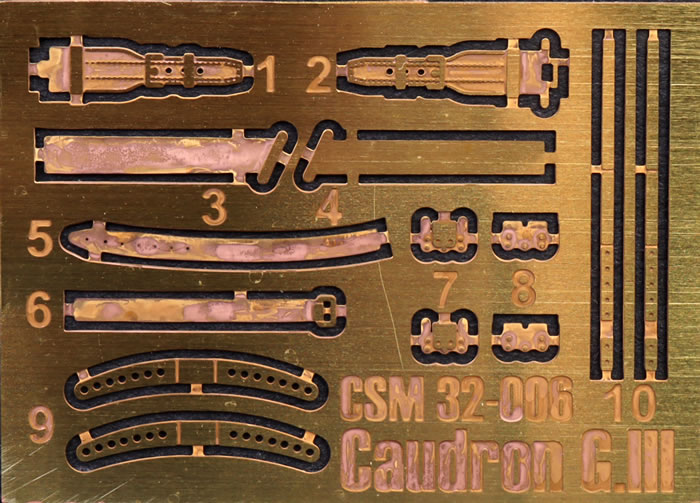
As I will mention later, the original production kit only have FOUR scheme. The pre-order ones, like this example on review have THREE extra schemes coming for the extra decal sheet.
The kit have six grey sprue, one transparente sprue, one PE sheet, and two decals sheets (the normal release will only have one decal sheet).
Sprue A
The main parts of the cockpit are here with good detail like the cockpit floor, rudder bar, control column, instruments (All he other parts as fuel tank and cockpit wall are on sprue and also on sprue b) So the cockpit parts are spread apart in 3 sprues.
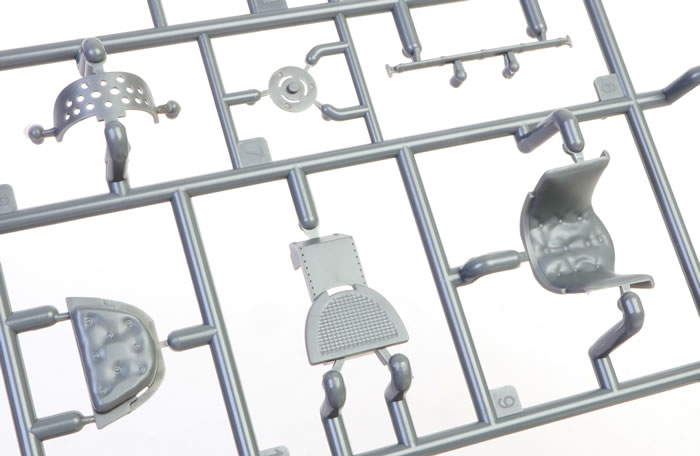
You can see the top wing central section. Yes central wing, so the wingspan is much bigger as the top wing tip section (left and right) is almost as the same size as the central wing.
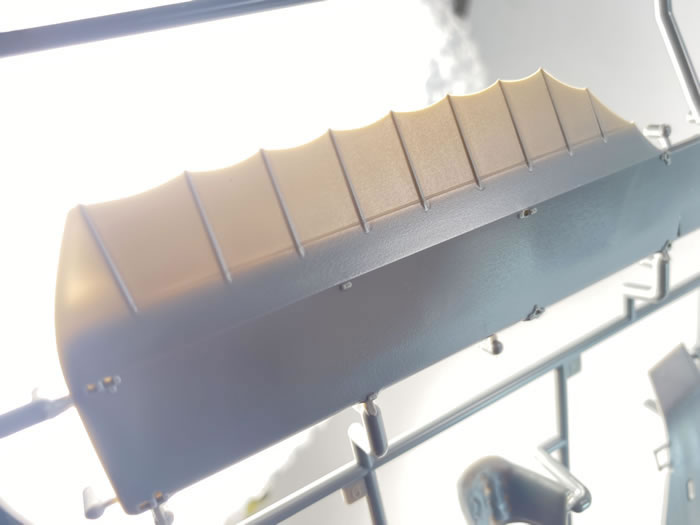
The wing look very well design with good fabric and structural detail.
The “flaps” do have some translucent look at the light and it’s a nice effort from CSM but I think it could have been a little more thin as the 1:32 WnW Taube on its mighty wings.
Also the bottom fuselage part are present and the cabane struts. These look quite fragile, but it`s a Caudron…
Sprue B
The main part is the lower wing and the fuselage haves.
The lower wing is a single piece, not like a 3 parts wing like the upper one. The details and translucent look is equal to the upper wings and as said, it´s quite good.
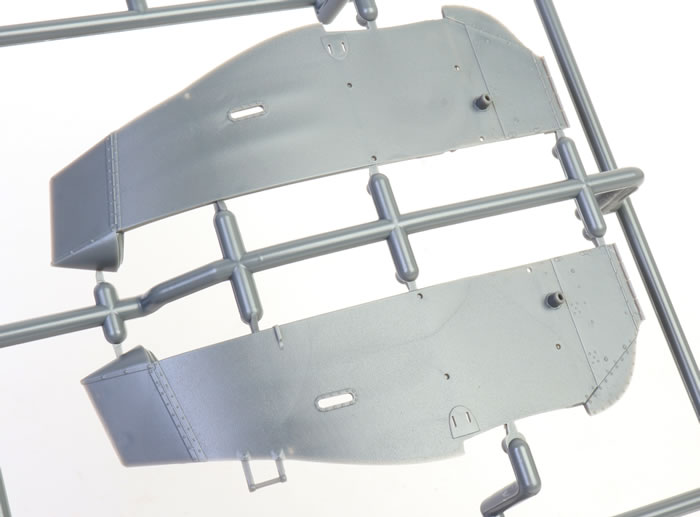
The interior of the fuselage has the internal structure with a well capture detail. The cockpit floor is a single piece with the rivets well present. Both seat are very well detail, and I really like the look of the pilots sit. It’s really look like a cosy leather chair. A good painting work is all it needs.
Sprue C
Checking close this sprue, the details are well represented and very sharp.
The horizontal stabilizer and tail elevators are quite fragile and the location points are well put and easy to remove.
The tail elevator don’t have the same translucent looks of the wings.
Also here is a cockpit part - cockpit floor. The layout of the sprues is quite curious as you got parts in sprue A, B and C to make the cockpit alone.
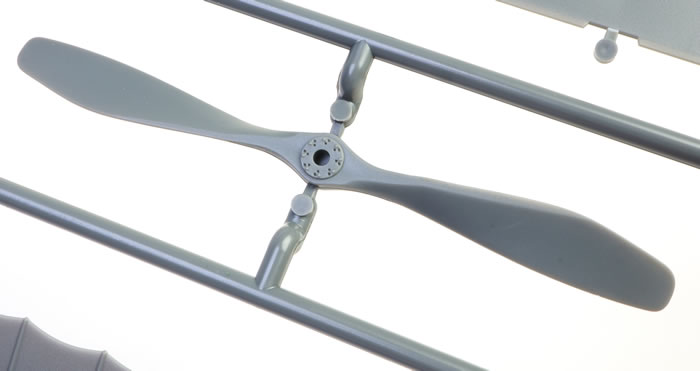
A single propeller is given. Any reference is given of what kind of propeller is But I think that is a Waring and Gillow Propeller.
Anyway, Proper Plane already release two type of propeller for the Caudron G.III for 33$ each. Check it here.
Sprue D
Tail boom… The most daunting part of this kit… maybe not as you will see whne we got to the instructions.
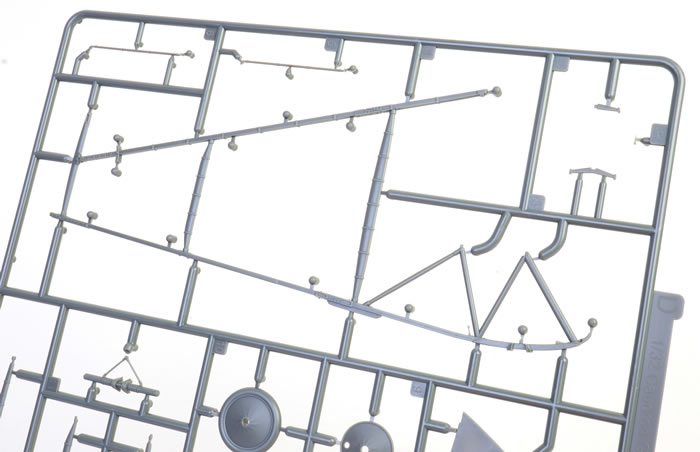
Besides tail boom, the main structural parts are here like the wing struts that have very good surface detail.
Besides that, wheels and ruder parts made each of this sprue.
Sprue E
A single sprue for the engine. The example given is the Le Rhone 9J 80 hp.
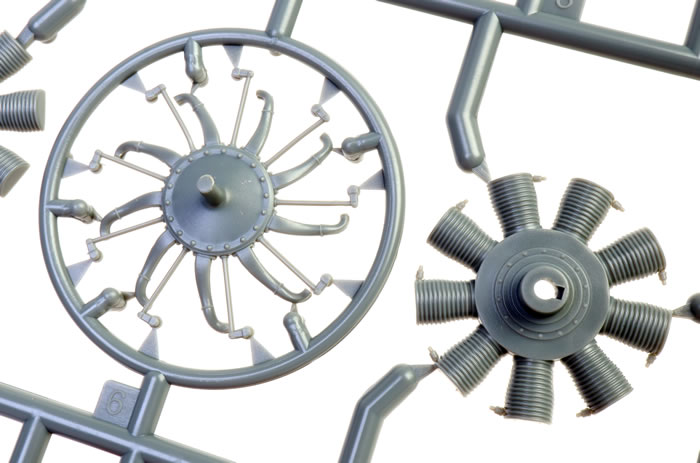
Looking at the steps constructions and the details, it`s an easy build with a vey good details in a straight build.
Sprue F
The clear parts.
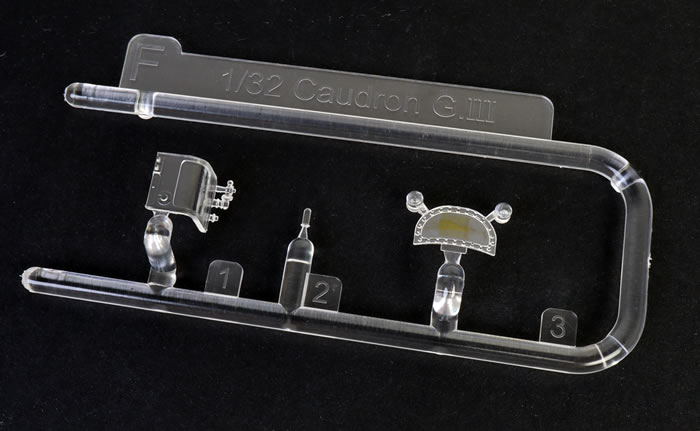
There`s not much of this as usual in WWI airplanes, so the windscreen. Any way, the clarity is excellent and the framing is very well defined.
Instructions
A 29-page A4 manual is included which starts with a very brief history of the type, with a highly detailed and clear step by step easy to follow.
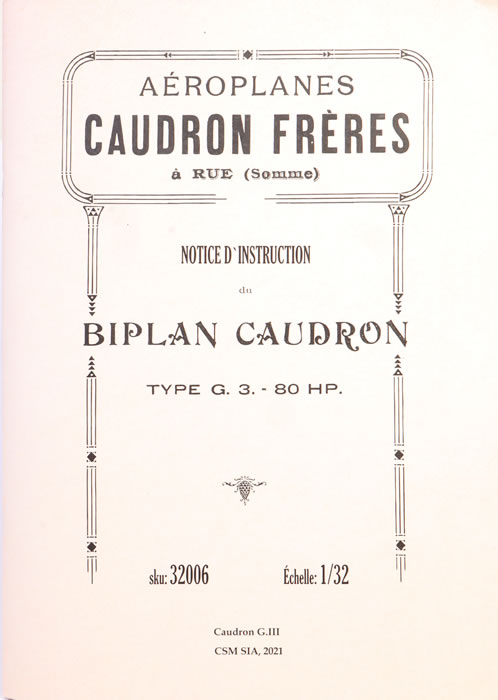
All illustration is in line drawing format which is clear and easy to follow, with very good annotation for paint, parts options and decals (where applicable).
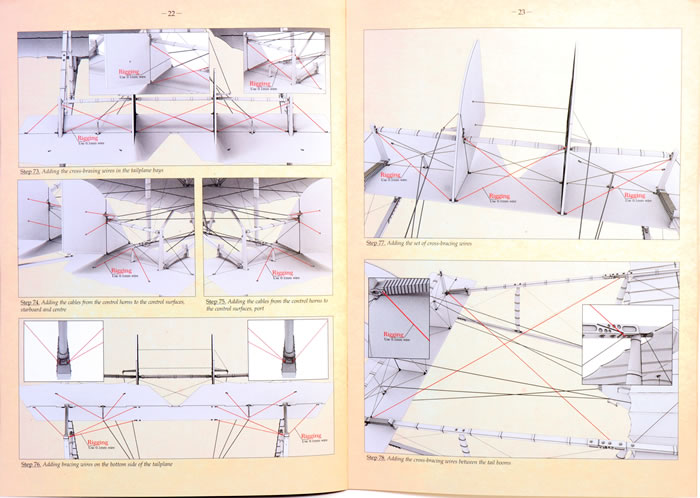
With a Airplane with such rigging, there`s no rigging diagram for the final aircraft, as the rigging instructions just made their way in all the constructions. It’s a method that for this airplane I think, in fact, that`s the best option.. In fact there are several pages that all is rigging… more than 4 pages in a row.
However, one issue remain since I made 1:32 CSM Nieuport XVII Late type review
Markings
The paint indication: the names are pretty basic and it difficult to get which color specific is CSM talking about.
Here we got Doped Linen, Red Brown varnish, linen gloss, plywood, wood… a experience or even a intermediate modeler in WWI should have any problem with this but I think that is no big deal in putting some brand number color in it.. like Tamiya, AK-Interactive or other brand.
The seven schemes are:
Production Release
-
Caudron G.III ”Pegase”, C. 962, C.18 Escadrille, S. Lieut Boinvillers, Verdun, 1916;
-
Caudron G.III “Trompe La Mort”, C.18 Escadrille, Mdl Maxime Lenoir, Verdun, 1915;
-
Caudron G.III, Septemer 1914 (markings based on autochrome by Gervais-Courtellemont published in “Les Campes de Bataille de La Marne”
-
Caudron G.III, 914, unknow data ( all-blue painted parts)
Pre-Order Schemes Bonus
-
Caudron G.III “Le Grand Icare”, C.1001, Verdun 1915;
-
Caudron G.III, C.11 Escadrille, Summer 1916;
-
Caudron G.III, C. 991, C.28 Escadrille, Sgt Pierre Poisard, November 1915.
Two decal sheet contains the markings for all seven schemes.
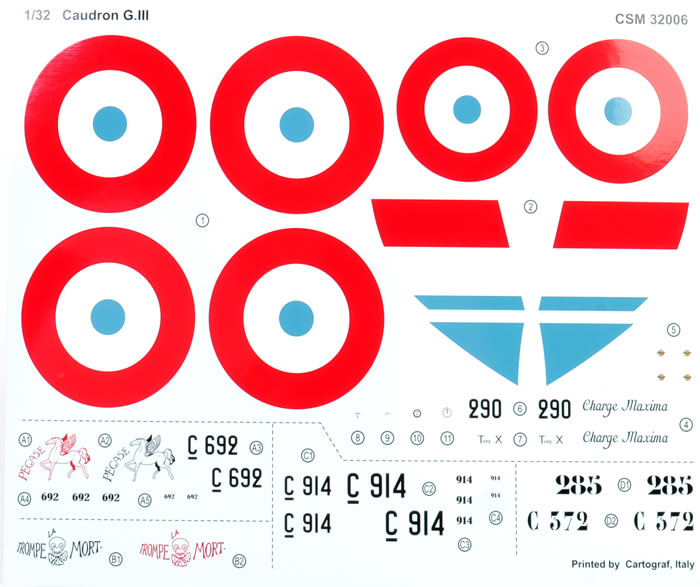
They are printed by Cartograf from Italy, so quality is granted , with minimal carrier film, good colour density and excellent register.

Decals are supplied for the instrument dials, but I would suggest punching these from the sheet for a perfect fit the various cockpit gauges.
The Caudron G.III is a stringbag in all its soul and CSM captures its silhouette and soul very well.
It`s quite a risk taken here by CSM to release this spectacular aircraft, as its WWI and less know that Fokker and Albatros but thanks to CSM for taking that risk.
A glance at the parts and the instruction, the model is well thought out and modeler friendly as far as constructions goes.
The rigging is not for fainted hearted, there's lots of it and it is very complicated.
This is the best Caudron G.III in any scale for sure, and it probably will for a very very long time and it`s in fact a very good looking model kit.
My sincere thanks to bank account for this beautiful model kit.
Review Text and Images Copyright © 2022 by Francisco Guedes
Page Created 31 January, 2022
Last updated
1 February, 2022
Back to HyperScale Main Page
Back to Reviews Page

|
Home
| What's New |
Features |
Gallery |
Reviews |
Reference |
Forum |
Search